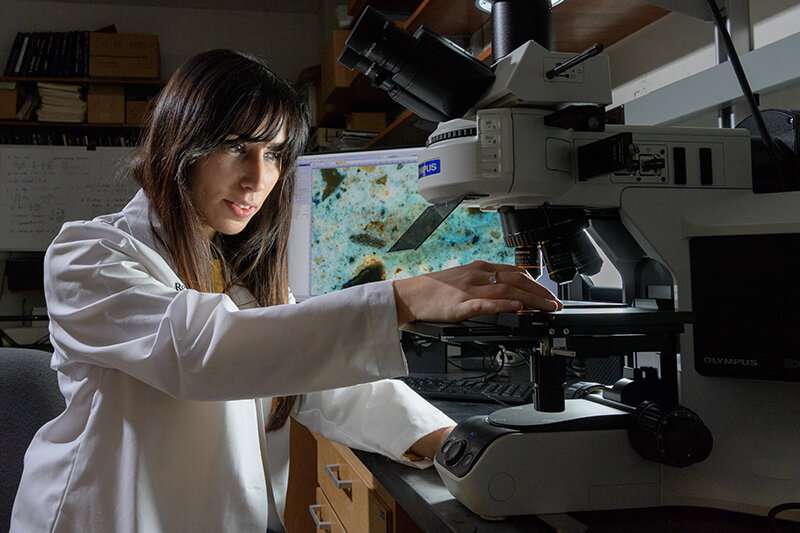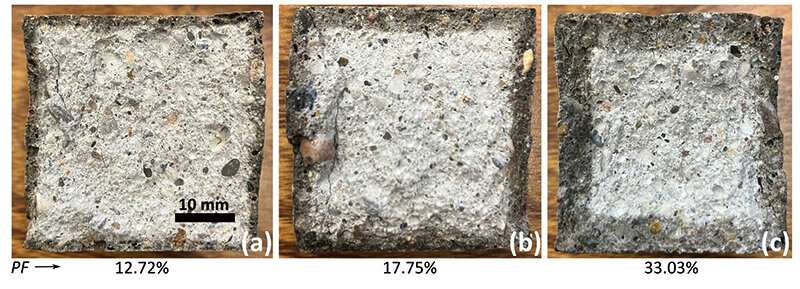This article has been reviewed according to Science X's editorial process and policies. Editors have highlighted the following attributes while ensuring the content's credibility:
fact-checked
trusted source
proofread
Helping construction material manufacturers reduce the energy consumption, carbon footprint of heating and cooling homes

Heating and cooling homes carries a hefty economic and environmental price tag. The U.S. Energy Information Administration has reported more than half of all home energy in the United States is used for heating and cooling, and it also represents more than 14% of the nation's overall energy use. According to the World Green Building Council, the buildings and construction sector is responsible for 39% of global energy-related carbon emissions.
Mirian Velay-Lizancos, a Purdue University assistant professor of civil engineering from the Lyles School of Civil Engineering in the College of Engineering, is addressing these issues. She and researchers in her laboratory have developed a patent-pending, scalable, automatable process that improves upon the traditional method to incorporate phase change materials, or PCMs, into construction materials.
The incorporation of PCMs like paraffin, esters and salt hydrates into building envelope elements moderates the effect of outside temperature changes on the indoor environment. They convert changes in thermal energy into phase changes by transitioning from a solid into a liquid, or the opposite. They provide useful cooling or heat by absorbing or releasing energy during those transitions.
"Incorporating PCMs reduces energy consumption in buildings, which reduces carbon dioxide emissions and operational costs," Velay-Lizancos said. "It also decreases water permeability of construction materials."
PCMs are used in a building's envelope, or the doors, exterior walls, foundations, roofs, windows and other components that create a barrier between the indoors and the outdoors. The thermal properties of building envelopes play a key role in a building's energy consumption.
"Increasing the heat storage capabilities of building envelopes would reduce the effect of temperature fluctuations in a building," Velay-Lizancos said. "This would increase the thermal comfort of the building and decrease energy consumption, carbon dioxide emissions and related economic costs of heating and cooling. It also would make buildings more resilient and energy independent and less susceptible to power outages and other energy supply issues."
Velay-Lizancos said traditional methods to add PCMs in construction materials have drawbacks.
"Currently, PCMs are incorporated into other materials via microencapsulation or macroencapsulation," Velay-Lizancos said. "However, these methods limit the use of PCMs. Microencapsulation has a negative effect on the strength and durability of construction materials. Macroencapsulation limits the shape and production method of construction materials."
Velay-Lizancos's method uses liquid immersion and a vacuum to incorporate PCMs after construction materials like bricks, drywall and concrete have already been formed.

"This increases the strength, enhances the durability and increases the thermal inertia of the construction materials," Velay-Lizancos said. "This new method also distributes PCMs so they are concentrated in the surface layer of the construction materials. More of the PCMs are in contact with external surfaces of the building envelope, which makes the PCMs more effective."
Velay-Lizancos's method requires only a vacuum system, which she said is very accessible and easy for manufacturers to work with.
"Users will need to be familiarized with the process, but they will not need special training," Velay-Lizancos said. "The process could be easily automatized and incorporated into the production chain of precast elements like bricks, concrete panels, drywall and pavers, among others."
Velay-Lizancos and her research group tested the innovation at the Pankow Laboratory in the Lyles School of Civil Engineering. The initial tests were conducted with commercial bricks and 15 minutes of vacuum time.
A large experimental campaign was conducted on cement mortars with three water-to-cement ratios and, therefore, different initial porosity levels. PCMs were incorporated into the mortars for three different vacuum periods: 15 minutes, 1 hour and 4 hours. Velay-Lizancos and her team observed an increase on the thermal inertia of 24% and over a 22% of increase in the compressive strength, with just 7% of the volume of the element filled with PCM.
Velay-Lizancos said the uneven distribution of the PCM concentrated in the surface layer makes the PCM more effective in enhancing thermal properties.
"The method used in this study introduces the PCM into the layer of the material that is closer to the material's surface, meaning that more will be in contact with the external surfaces of the building envelope, resulting in more effective usage of the PCM," Velay-Lizancos said.
"Furthermore, this method pushes the PCM material into the capillary pores through the vacuum. Due to the capillary forces, leakage of PCM was not observed, even when the final composite was exposed to high temperatures well above the melting point of the PCM used."
A paper describing the research methods and results has been published in the March 2023 issue of the journal Construction and Building Materials.
The next milestone to develop the PCM incorporation method is to build a full-scale prototype.
"This will allow us to visualize with cameras and sensors the thermal performance of the building envelope," Velay-Lizancos said. "Clients will have the hard data and also be able to visualize the advantages of this technology."
More information: Marina Lopez-Arias et al, High thermal inertia mortars: New method to incorporate phase change materials (PCMs) while enhancing strength and thermal design models, Construction and Building Materials (2023). DOI: 10.1016/j.conbuildmat.2023.130621















